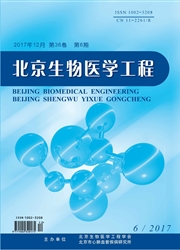

 中文摘要:
中文摘要:
目的提出用磁共振三维容积成像方式研究流体迁移对人体上气道截面及颈围影响的方法并验证其可行性,为探讨体位改变对睡眠呼吸功能的影响提供新的思路。方法使用三维扰相梯度回波序列(3D-SPGR)容积扫描方式,对2位受试者头颈部自鼻腔顶部至喉结处进行两种状态下的横断面磁共振成像:平卧参考状态;将双腿抬起大于50。角并持续8min后的流体重新分布状态。从选定横断面的图像上提取两种状态下上气道截面和颈围边界的坐标,进而计算气道横截面积以及颈围周长。结果图像可清楚地显示流体迁移引起的上气道截面积、形状,及颈围尺度的变化。计算结果表明,抬腿引起的流体迁移导致上气道截面积减小、颈围增大,与现有文献中给出的实验结果一致。结论将磁共振三维容积成像的方法用于流体迁移对人体上气道形态影响的研究,可方便、精确地测量由于流体重新分布引起的上气道截面积、形状,及颈围尺度的变化。这一方法将为研究体位改变对睡眠呼吸功能的影响,特别是伴有水肿现象的疾病与阻塞性睡眠呼吸暂停相关联的机理提供一个有效的途径。
 英文摘要:
英文摘要:
Objective To propose a magnetic resonance imaging (MRI)procedure for 3D volume scanning to study the effect of fluid shift on the cross section of the upper airway as well as the neck circumference,and to test the feasibility of this strategy. A new thought was provided for exploring the effects of body posture changes on the respiratory functions during sleep. Methods A procedure using 3D- SPGR scanning from the top of nasal cavity to laryngeal prominence of two subjects was conducted under two conditions:the control test with subjects lying supine, and after fluid redistribution resulting from elevating both legs for 8 min. The coordinates of the neck and the upper airway boundaries were extracted directly from theselected axial images to calculate the neck circumference and the cross-sectional area of the upper airway. Results The images showed clearly the changes in the neck circumference and the cross-sectional area and shape of the upper airway. The results indicated that the fluid shift caused by raising legs could narrow the upper airway and increase the neck size, which were consistent withcurrently published experimental results by other investigators. Conclusions Using the 3D volume MRI technique to study the effects of fluid shift on the upper airway patency,we can easily and accurately measure the changes in the neck size and the cross-sectional area and shape of the upper airway. This method could provide an effective way to investigate the effects of body posture changes on the respiratory functions during sleep, as well as the mechanism behind the correlation between fluid-retaining related diseases and obstructive sleep apnea.
 同期刊论文项目
同期刊论文项目
 同项目期刊论文
同项目期刊论文
 期刊信息
期刊信息
